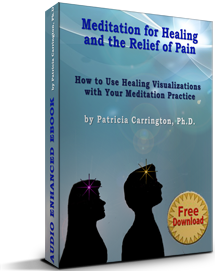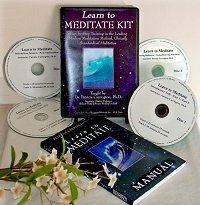Dr. Patricia Carrington's award winning meditation technique CSM (Clinically Standardized Meditation) is a clinically sensitive meditation method developed by the Medical Department of New York Telephone Company and used by numerous medical institutions, organizations, and individuals worldwide. For information click here.
Meditating to Increase Creativity
Increased Productivity with Meditation
Patricia Carrington, Ph.D.
Author of “The Book of Meditation”
Increased productivity often depends on the ability of ideas to flow easily and rapidly. Meditation may bring about such a release of ideas. As I described in Chapter 1 of my Book of Meditation, within a week of learning to meditate, my late husband was able to write a forty-page scientific paper that he had been postponing for six months. In contrast to his previous difficulties with it, his ideas now flowed unhesitatingly, a change he traced to the free floating thought of meditation, where images and ideas drift unhampered by self-criticism.
Within the first week of learning meditation, one of my patients discovered that she could do crossword puzzles with great ease, something she had never been able to do before. Her previous inability to do these puzzles was related to the fact that she had always had difficulty in any situation (such as an examination) where she was required to ‘switch perspective’. She would arrive at an exam having studied the course material thoroughly from one viewpoint only to find herself unable to tackle it from the different perspective required by the test. In the same way, when trying to do a crossword puzzle she used to ‘get into a rut’. Seeing one possibility for a word, she could not abandon this when it did not fit so as to enable herself to scan her memory for other words, a necessity for creative puzzle-solving. Meditation, however, seemed to unlock her ability to shift gears mentally. She was now free to reshuffle ideas into new combinations.
One of the most impressive effects of meditation on blocked productivity which I have witnessed occurred in a college student.
|
MEDITATION AUDIO LESSON Preparatory Meditation
Join Dr. Patricia Carrington as she demonstrates two brief exercises you can do to prepare to meditate. Many people find these preparatory exercises deepen the meditation experience and make it more meaningful.
|
Susan was a brilliant young woman and an outstanding scholar, but when she was an undergraduate at Princeton she was so self-critical and a perfectionist that she was unable to write more than a few pages of her junior paper (a key requirement at the university) without tearing it up in disgust. Although she had completed research for the project, she faced the equivalent of the familiar writer’s block in preparing it. Her six months of work resulted in continual frustration and she was in danger of failing her junior year because of this stalemate.
When her visits to the counseling service on campus and my considerable encouragement as her adviser failed to help her, I suggested that she learn meditation. Susan agreed, went to learn TM, and for two weeks after that did not contact me. At the end of this period, she walked into my office and handed me a thirty-five-page typed manuscript, a complete draft of the paper. When I read it I realized it was more than a draft; with little change it could be submitted as a solid piece of research, more than fulfilling her junior independent work requirement.
Susan later told me that the reason she had finally been able to write her research study was that meditation had literally ‘opened up the floodgates’, permitting her ideas to flow again. A particularly important aspect of this incident is the continuing effects meditation had on her. She was now able to handle her studies with ease, and began to realize her full academic potential. A year later, she graduated from Princeton, Phi Beta Kappa, and received highest honors.
Aside from anecdotes such as the above, there is some experimental evidence suggesting that meditation may help to increase productivity. In Melissa Hines’s study on meditation and creativity conducted at Princeton University, she found that what psychologists call ‘ideational fluency’, a tendency for mental associations to flow easily, rapidly and productively, can be influenced by meditation.1 There was a significant increase in ideational fluency in the Zazen meditators she studied over the ten-week period, while the control subjects’ ideational fluency was unchanged.
Curiously, this improvement in the meditators took place almost entirely in the last four weeks of the study. During the first six weeks, there was relatively little improvement. This suggests an accumulative effect of meditation on certain mental processes connected with creativity. Perhaps the longer a person has been meditating, the more likely it is that she will have personality changes in the direction of increased perceptual openness and ideational fluency. Since a number of people report an almost immediate ‘opening up’ of productivity after beginning meditation, however, it is obviously not necessary for everyone to have been meditating a long time for this to occur.
1. M. Hines, ‘Meditation and Creativity: A Pilot Study’ (senior thesis, Princeton University, 1970), p. 11.


